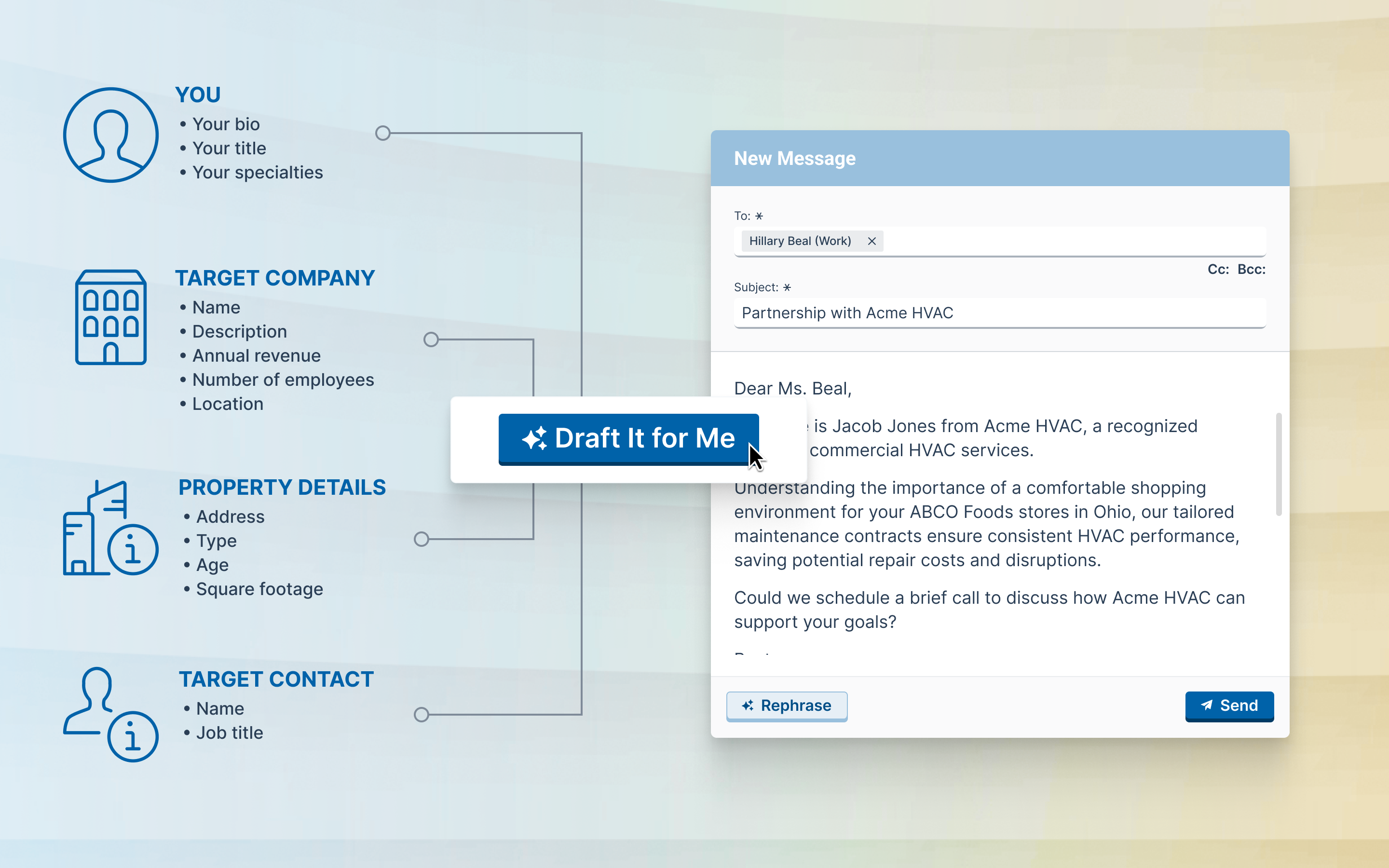Introduction: The Challenges of Prospecting for BAS
Selling building automation systems (BAS) today isn’t just about having the best tech to sell; it’s about finding the right buyers at the right time. If you’re a sales rep or manager in this space, you’ve likely faced some of these frustrations:
Endless outreach to facility managers who aren’t decision-makers.
Chasing retrofit projects that stall due to budget constraints.
Competing with vendors who undercut on price but offer little value.
Despite the challenges, the Building Automation Systems (BAS) market is on a massive upward trajectory, projected to surpass $114 billion by 2035. This growth will open up a wealth of opportunities to those selling systems, yet the landscape is becoming increasingly complex.
For starters, people are getting less responsive to outreach. Email open rates are tumbling; modern smartphones are filtering calls from unknown numbers, and advertising to targeted leads on platforms like LinkedIn has more than doubled in price since pre-COVID.
What’s more, integration hurdles, outdated legacy systems, and substantial upfront installation costs frequently slow or derail projects that seem like the perfect fit.
To navigate these challenges and the evolving marketplace successfully, you have to move beyond merely compiling a list of local buildings. Today, you need a strategic, targeted prospecting approach that can overcome them.
Which is why in this guide, we’ll walk you through a 5-step process to build a high-quality BAS prospect list that aligns with real buyer needs and your sales goals.
1. Define Your Ideal Customer Profile (ICP)

It may seem elementary if you’ve been in sales for a while, but everything in sales starts with an Ideal Customer Profile (ICP). Your ICP is the foundation of building an effective prospecting process.
For BAS sales and business development representatives, this isn’t just about building size or industry; it’s about identifying organizations with the right mix of need, budget, and urgency.
But unless you have modern sales intelligence tools or insights into local regulations, that combination is very hard to spot.
Key ICP Attributes for BAS Sales:
Building Type: Beginning with a focus on commercial offices, hospitals, K–12 schools, universities, and manufacturing facilities gives you the best chance of starting conversations with people who are already concerned about these issues. Also, these structures often have complex systems that can benefit significantly from automations that can help them track key conversational points like “environmental impact.”
Square Footage: If you want to win big deals, you should also consider targeting buildings typically over 50,000 sq ft, where the return on investment (ROI) from automation is more substantial due to higher energy consumption and operational complexities. This is especially true in manufacturing.
System Age: Another significant factor, especially on the coasts, is buildings with outdated or siloed systems, generally those over 10 years old. These systems rarely meet local ordinances and are prime candidates for upgrades to integrated BAS solutions.
Energy Spend: Like system age, high utility costs can indicate inefficiencies that BAS can address, leading to potential savings and a compelling value proposition to decision-makers.
Regulatory Pressure: Regions with stringent energy codes or sustainability mandates often necessitate advanced building automation to comply with regulations.
Once you have built your ICP, you have to find property intelligence tools that are specifically designed to help you find the key decision-makers at the property level.
Pro Tip: Use tools like Convex, which incorporates both property intelligence and sales intelligence data to identify buildings that match these criteria, the decision-maker in charge of that location, and other detailed information, including permit history and, in some cases, building equipment data.
2. Build Buyer Personas for Key Stakeholders

In building automation system (BAS) sales, you’re not just selling to a single individual. Each stakeholder—whether it’s a facility manager, energy manager, IT director, CFO, building owner, or property manager—has distinct priorities and concerns. Understanding these nuances is key to tailoring your approach effectively for that persona.
Now, many of the properties you’ll be prospecting won’t have all of these titles - in fact, only larger organizations will have many of them, but understanding their focus, pain points, concerns, and how to engage them will make your job far easier.
Facility Manager
Primary Focus: Operational efficiency and system reliability.
Pain Points: Aging infrastructure, limited staff, and the pressure to maintain uptime.
How to Engage: Emphasize how your BAS solution can streamline operations, reduce manual interventions, and provide real-time alerts to preempt issues.
Energy Manager
Primary Focus: Sustainability goals and energy savings.
Pain Points: Meeting energy reduction targets, complying with regulations, and justifying investments.
How to Engage: Highlight the energy analytics capabilities of your BAS, showcasing potential ROI through case studies and energy savings projections.
IT Director
Primary Focus: System integration and cybersecurity.
Pain Points: Ensuring new systems don’t compromise network security or create integration challenges.
How to Engage: Discuss how your BAS adheres to IT protocols, supports open standards, and includes robust security measures.
CFO/Finance
Primary Focus: ROI, total cost of ownership, and budget alignment.
Pain Points: Justifying capital expenditures and managing long-term operational costs.
How to Engage: Provide clear financial models, including payback periods, maintenance savings, and potential incentives or rebates.
Building Owner/ Investment Group
Primary Focus: Asset value and tenant satisfaction.
Pain Points: Maintaining property value, reducing vacancy rates, and differentiating in competitive markets.
How to Engage: Demonstrate how your BAS can enhance building performance, contribute to green certifications, and improve tenant comfort.
Property Manager
Primary Focus: Day-to-day building operations and tenant relations.
Pain Points: Responding to tenant complaints, coordinating maintenance, and managing vendor relationships.
How to Engage: Show how your BAS provides actionable insights, simplifies maintenance scheduling, and improves tenant communication.
Pro Tip: Conduct interviews with existing clients who share a similar title to delve deeper into these personas. Understanding their challenges and decision-making processes will refine your sales approach and messaging.
3. Use Intelligence Tools to Source and Filter Leads
Now, it’s time to build your actual prospecting list. If you’ve been in the business for a while, you know manual prospecting is time-consuming and often ineffective. Things like generic cold calling and email blasts are increasingly yielding diminishing returns.
Instead, leverage smart technology like sales intelligence and property intelligence, as well as social networks, to identify and prioritize high-quality leads.
Strategic Tools for Modern BAS Prospecting
Convex: Utilize Convex to access comprehensive property intelligence, including building attributes, permit histories, and other data points at the property level. This information enables you to pinpoint buildings that align with your Ideal Customer Profile (ICP) and understand their specific needs.
Building Radar: Stay ahead by identifying new construction projects and major renovations early in their development. This foresight allows you to engage with stakeholders before competitors, positioning your solutions as integral from the outset.
LinkedIn Sales Navigator: Leverage “Sales Nav” as it's known among sales pros to connect with professionals based on specific roles, industries, and company sizes, ensuring your outreach is both targeted and relevant.
Key Filtering Criteria to Enhance Lead Quality
When utilizing Convex, there are many ways to refine your prospect list
Building Age and Size: Focus on structures over 50,000 sq ft and those with outdated systems, as they often present greater opportunities for BAS upgrades.
Industry and Location: Target industries like healthcare, education, and manufacturing, especially in regions with stringent energy regulations, where BAS solutions can offer significant compliance and efficiency benefits.
Recent Renovations or System Upgrades: Identify buildings undergoing changes, as these transitions often open the door for implementing advanced automation systems.
Buyer Intent Signals: We’ll talk about this more in the following “Pro tip,” but this may be the most powerful way to find warm leads in your market.
Pro Tip: Detecting Buyer Intent with Convex Signals
Beyond identifying potential leads, understanding their readiness to engage is crucial. Convex Signals offers insights into buyer intent by analyzing behaviors and indicators that suggest a prospect is actively seeking solutions. By prioritizing outreach to these high-intent leads, your team can allocate resources more efficiently and increase conversion rates.
4. Clean, Enrich, and Segment Your Data
A cluttered or outdated prospect list can derail your sales efforts. Ensure your data is accurate, complete, and organized.
Steps to optimize your data:
Clean: Remove duplicates and verify contact information.
Enrich: Add missing details like job titles, email addresses, and phone numbers.
Segment: Group prospects by industry, building type, or buying stage.
Pro Tip: Regularly update your CRM with new information and notes from interactions to maintain data integrity.
5. Personalize Outreach with Contextually Relevant Messaging

Finally, send a message! But beware, in today’s noisy world, generic messages get ignored. Tailor your communication to address the specific needs and pain points of each prospect.
Why Personalization Matters
Personalized outreach demonstrates that you’ve done your homework and understand the specific needs and challenges of your prospect. This approach not only captures attention but also builds trust and increases the likelihood of engagement.
Strategies for Effective Personalization
Reference Specific Building Details: Mentioning particular attributes of a prospect’s facility, such as its age or recent renovations, shows that your message is tailored. For example: “I noticed your facility at [Address] is over 20 years old, which might present opportunities for energy efficiency improvements through modern BAS solutions.”
Highlight Relevant Benefits: Align your message with the prospect’s goals, such as sustainability or cost savings. For instance: “Our BAS can reduce energy costs by up to 30%, supporting your sustainability initiatives and reducing operational expenses.”
Utilize Multiple Channels: Engage prospects through a combination of emails, phone calls, and LinkedIn messages to increase the chances of connection.
Leveraging Generative AI for Scalable Personalization

Crafting personalized messages for each prospect can be time-consuming. Generative AI tools, like those offered by Convex, can streamline this process by:
Analyzing Prospect Data: AI can assess information such as building attributes, energy usage, and organizational structure to inform message content.
Generating Tailored Messages: Based on the analyzed data, AI can draft messages that address specific pain points and objectives of each prospect.
Maintaining Consistency and Quality: AI ensures that all outreach maintains a high standard of relevance and professionalism, even at scale.
Here’s an example of personalization you can use as an email template:
Subject: Enhancing [Building Name]’s Efficiency & Compliance
Email: Hi [Recipient’s Name],
I came across [Building Name] at [Address] and noticed it’s a [Building Type]. Given its size and the fact that its current systems are around [System Age] years old, there might be opportunities to lower energy spend and increase efficiency to ensure compliance with recent [Local/State] energy regulations.
My team has assisted facilities like yours in reducing energy costs by up to 30%, while also simplifying system management and ensuring regulatory compliance.
Do you have a few minutes to chat about how we can support you in achieving efficiency goals? A brief 15-minute call next week should be enough for us to see if there’s a reason to do a deeper dive.
Looking forward to connecting.
Best regards,
[Your Name]
Pro Tip: Utilize Convex’s generative AI tools to craft personalized messages at scale (think 3- 5 minutes per prospect rather than 90 minutes+), saving time while maintaining quality.
Conclusion
Building a targeted prospect list for BAS sales isn’t just about quantity—it’s about quality and relevance. By defining your ICP, understanding buyer personas, leveraging smart tools, maintaining clean data, and personalizing your outreach, you position yourself to connect with the right prospects at the right time.
Ready to see how Convex can streamline your prospecting process and boost your BAS sales? Schedule a free demo today.
Share



![Inbound vs Outbound Sales for Commercial Services [2025]](/_next/image?url=https%3A%2F%2Fimages.ctfassets.net%2Fbva4sbdc8p9r%2F6NMwDZPptrxmnyVSierCwe%2Fa976905c390479329de6e284f1c7d5d5%2F010203-Convex-Blog-InboundvsOutboundSalesforCommercialServices-MainHero-1200x630_1x.jpg&w=3840&q=75)

